Last Updated on March 2, 2025 by Owen McGab Enaohwo
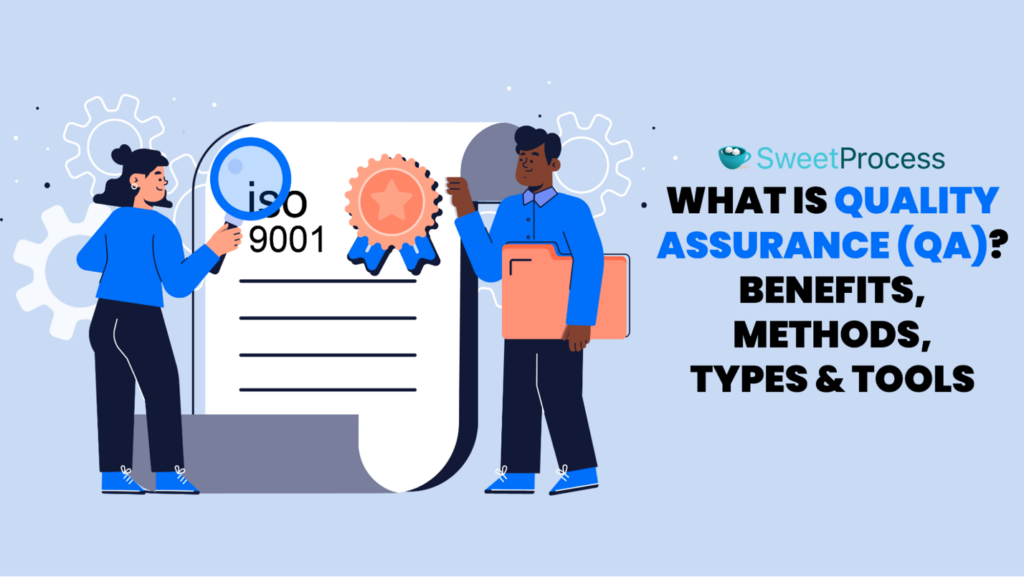
Your company may offer services or raw materials, but that’s not what guarantees success. There’s a key ingredient that determines whether you stay profitable or go bankrupt.
Without it, your profits will drop, and your customers won’t return if the quality of your products or service doesn’t meet their expectations.
So, how can business owners and managers handle quality control? It’s through quality assurance!
In this post, we’ll show you what it is, how to implement it in your business, and tools that will simplify the process for you.
If you’re serious about quality assurance in your business, SweetProcess makes it easy to handle. Try it for up to 14 days free. No credit card is required.
What You’ll Learn In This Blog Post:
Why Is Quality Assurance Important for an Organization?
How to Improve Your Company’s Quality Assurance Process With SweetProcess
7 Quality Assurance Best Practices You Should Use In Your Organization
6 Approaches to Quality Assurance
Quality Assurance Examples in Different Industries [+ How It Works]
Quality Assurance vs. Quality Control: How Do They Differ?
Enhance Your Company’s Quality Assurance Process Using SweetProcess
What Is Quality Assurance?

Quality assurance (QA) is a process designed to ensure that a company’s products or services are standardized and meet customer’s needs. This way, they cut down maintenance costs, reduce time to market, satisfy customers’ needs, build a good reputation, and comply with regulatory bodies.
Integrating QA into business operations can transform a brand’s success through operational efficiency, spotting service errors to adjust, maintaining consistent product quality, and process standardization.
Types of Quality Assurance

Below are some types of quality assurance you can adapt in your business:
1. Process Quality Assurance
Process quality assurance (PQA) is a quality assurance that is concerned with careful adherence to processes that deliver the best product or service quality possible. By identifying and documenting processes and procedures, process controls and audits, and setting clear quality objectives, PQA helps analyze and refine processes to reduce defects and errors.
2. Product Quality Assurance
Product quality assurance (QA) ensures your products meet specific standards and customer expectations. This sort of QA consists of product design, material selection and inspection, manufacturing process controls and monitoring, product testing, and spotting and fixing product weak points to reduce the risk of any product recall and enhance business reputation.
3. Organizational Quality Assurance
Organizational quality assurance is an all-inclusive approach to quality management that ensures the company’s entire quality management system is efficient.
It includes developing and implementing quality policies and procedures, listing quality standards, training and employee onboarding programs, internal audits, management review and continuous improvement to ensure quality is blended into all the business aspects. But you need an all-in-one software like SweetProcess to make this process easy, as trying to run this manually is tiring.
4. Supplier Quality Assurance
Supplier quality assurance, often abbreviated as SQA, is a systematic approach organizations employ to guarantee the quality and consistency of the materials, components, or services they obtain from external suppliers. Some of the activities to do this include materials inspection and testing, supplier selection and qualification, supplier audits, performance monitoring, and sorting of supplies.
5. Functional Quality Assurance
In this case, it ensures that each unit under a company is up and running effectively. It is meant to assess and refine procedures and processes in every department by laying down quality objectives, running regular process audits, and identifying or adjusting functional quality to improve efficiency, save costs, and meet customer expectations.
6. Software Quality Assurance (SQA)
Software quality assurance is an approach to making software applications meet certain requirements and industry standards. The terms “what is quality assurance testing,” “what is software quality assurance,” and “what is QA testing” all refer to the same idea. It helps companies to build software products without major defects to satisfy customer needs. It involves activities like software design, code inspections and testing, software testing, debugging of software glitches, and software updates.
7. Regulatory Compliance Quality Assurance
Quality assurance is the process of systematically monitoring and evaluating production processes to ensure that products consistently meet specified quality standards. It encompasses various measures, such as product testing, inspections, and adherence to established benchmarks.
Likewise, compliance refers to the adherence to industry regulations, safety standards, and legal requirements. It involves documenting quality objectives that align with regulatory bodies for your staff to follow so you can lower the chances of paying fines due to non-compliance.
Why Is Quality Assurance Important for an Organization?

Let’s briefly look at some of the benefits of quality assurance in a business:
1. Saving Maintenance Costs
Quality assurance testing can help cut down on maintenance costs by ensuring thorough testing of new releases and patches.
For instance, if a bug is detected in a legacy system, an effective test plan can save time by replicating the issue and providing developers with clear steps to identify a solution.
This saves them from getting bad user reviews or having to waste time and resources on software patches and updates later.
2. Reducing Time to Market
Using quality assurance, companies reduce time to market by creating, packaging, and launching products without second-guessing, as all procedures for making and refining them have been laid down.
For example, a pharmaceutical company implements QA processes to make and approve new drugs.
They can sieve dirty particles and produce only safe, clean, and healthy drugs for treatment in less time.
3. Consistently Meeting or Exceeding Customer Expectations
Another important aspect of quality assurance is that it helps to establish and maintain a process that ensures products or services consistently meet or exceed customer expectations.
When quality procedures are written down for employees to follow in a knowledge base or training manual, every single staff member can simply follow the guidelines without compromising on quality.
So if, for instance, a clothing brand creates outfits with the same design, feel, and quality, its customers will trust the brand and stay loyal.
4. Enhancing Brand Reputation
Quality assurance contributes to brand reputation by ensuring consistent product quality, thereby building customer trust and loyalty.
Once your business meets customer expectations all the time you won’t need much persuasion to win trust and attract more customers.
However, it’s hard to pull this off when every staff member in your company assumes what to do in what stage of production or service delivery.
That’s why you need a quality assurance platform that houses all of your process steps to avoid missteps and errors.
5. Ensuring Compliance With Regulatory Requirements
Implementing quality assurance not only helps achieve industry standards but also maintains them over time. When you have internal policies and bylaws that align with your industry’s regulatory requirements, your company stays safe and profitable without unnecessary legal battles or fines.
For example, when you register with the anti-money laundering agency and comply with the agency that checks for such fraudulent transactions, you won’t have to appear in court when they investigate your business.
6. Improving Operational Efficiency
Quality assurance enables a company to identify key metrics for evaluating performance and use them to change organizational practices that improve operational efficiency positively.
Again, when your staff knows the right steps to take, mistakes to avoid, or how to respond to customer inquiries, your operations flow better, and customers feel happy.
Why? Quality assurance is in order.
But you can’t change this when your business processes are scattered in different documents. You need a quality assurance tool like SweetProcess to house everything in one place.
7. Disclosing Weaknesses in Processes and Procedures
Quality assurance plays a crucial role in Continuous Quality Improvement (CQI) by uncovering flaws in an organization’s processes and procedures.
By identifying inefficiencies and bottlenecks, CQI enables businesses to refine or eliminate ineffective processes, ensuring that only the most efficient workflows remain. This ongoing evaluation helps maintain high standards and fosters a culture of continuous enhancement.
8. Ensuring Supplier Quality
It’s only when you have precise requirements or expectations that you can spot the difference between good and bad raw materials or services.
When you have a quality assurance system in your company, anyone on your team can tell you the difference, and you get to produce quality products.
That’s because effective quality assurance helps to ensure that suppliers meet specified standards throughout the entire supply chain network.
9. Facilitating Process Standardization
Quality assurance involves defining criteria and setting quality goals, which facilitates process standardization.
Let’s say you run a hospital with a quality assurance system to check and refine your operations. Even your newly hired personnel can easily follow the steps to cure your patient’s ailment or disease.
This way, your medical personnel won’t get confused, skip steps, or forget to follow the practices that give optimal results for your patients.
How to Improve Your Company’s Quality Assurance Process With SweetProcess

Let’s go over some ways you can use SweetProcess to enhance quality assurance in your business:
Create Procedures and Processes
Go to procedures or processes on the main menu and click on “Create Procedure” or “Create Process.”

Give it a title.

Write a description of the steps to follow or carry out the procedure.

Click “Approve” to save it.
Document Your Company’s Policies
Go to the “More” tab and click on “Policies.”

Add a title that befits the policy.

Write the description of the company policy as you want.

Click “Approve” to save it.
Build an Internal Knowledge Base for Employees
Go to the “More” tab and select “Knowledge Bases.”

Click on “Create Knowledge Base.”

Give it a title and click “Continue.”

Scroll to the type box, write your knowledge base article, and select a theme if you want.
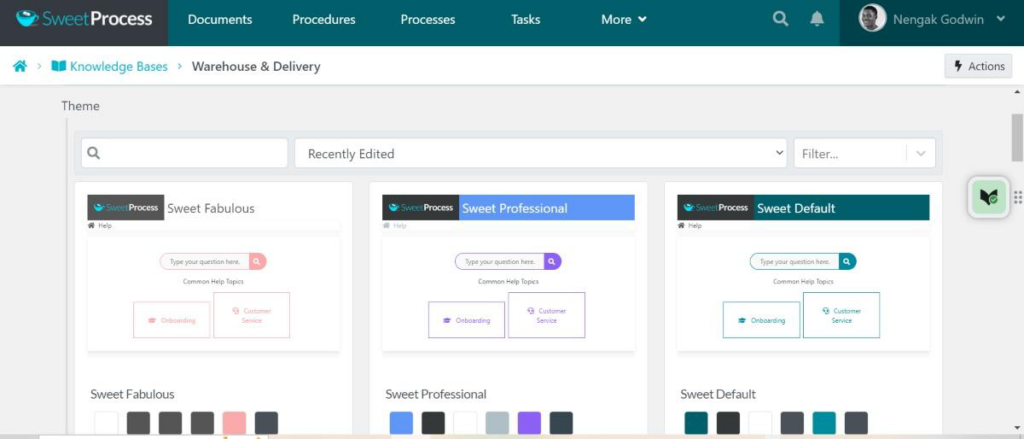
Once you’re done, click on “Approve” to save and scroll down and choose if you want to give the public access or only your logged-in staff.

Assign and Manage Tasks
Go to the “Task” tab and click on “Assign Tasks.”

Pick a procedure from your existing document.

Select a team member to assign it to.

Add a deadline to the task and save.

Collaborate With Team Members
When you want to share ideas with your teammates, simply tick the feedback form box at the bottom of any knowledge base document you create.

Also, you can click on the three dots beside a process, procedure, or policy document in order to delete, sign off, and share files with your team members.
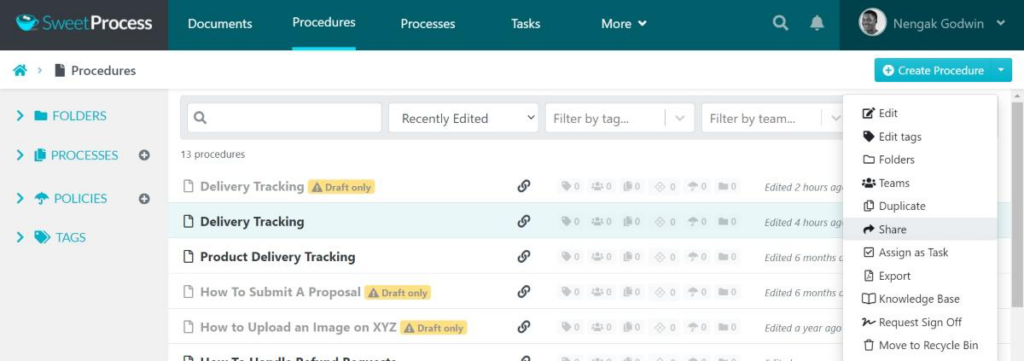
Many people have used SweetProcess to streamline quality assurance in their company.
Like Tom, the quality assurance and sensory coordinator at Stone & Wood Brewery, who initially struggled with maintaining quality assurance and smooth operations due to manual processes and outdated documentation.
Their regulatory compliance and inconsistencies in beer taste were also a concern. Their staff were using binders and Microsoft Word documents, which made updating procedures difficult and led to wasted time and resources when production had to be restarted due to errors.
After switching to SweetProcess, the brewery was able to enhance regulatory compliance, ensure consistent beer taste, and make fewer errors. This transformed their quality assurance and allowed them to produce high-quality beer while maintaining regulatory standards.
“We always struggled with following the due process, and to be honest, it’s something we still do,” says Tom. “But now, it’s far easier to get the guys on board with the procedures because they can access it from their phones, and we know that they are accessing the most up-to-date [procedure]. We can see that they’ve signed it off. Previously, there wasn’t any sort of tracking as to whether someone had looked into a procedure. That’s really made the difference.”
Similarly, David Brannen, the founder and managing lawyer at Resolute Legal, was driven by a passion for helping people with disabilities get the compensation they deserve.
However, the absence of a structure in his business was a hindrance. He struggled with juggling all the tasks on his hands until he learned that he would not grow unless he created a structure in his business.
“I had someone tell me probably in the six months to a year before I got SweetProcess that I would never be able to be successful or grow this business if I didn’t get out of my own way,” says David. “Basically, what he told me is: you got to systematize things.”
Caught up in the disorganization, David saw reason in the advice and decided to take action by looking for an effective system. A fellow lawyer who was conversant with SweetProcess mentioned it to him, and David checked it out.
And now, here’s what he has to say:
“SweetProcess is sweet for sure…it was responsible for me scaling up from a lone dude doing his own thing to having a real business with a bunch of employees and going from the guy trying to do everything in a crazy frantic state to someone who’s actually pretty comfortable right now.”
7 Quality Assurance Best Practices You Should Use In Your Organization
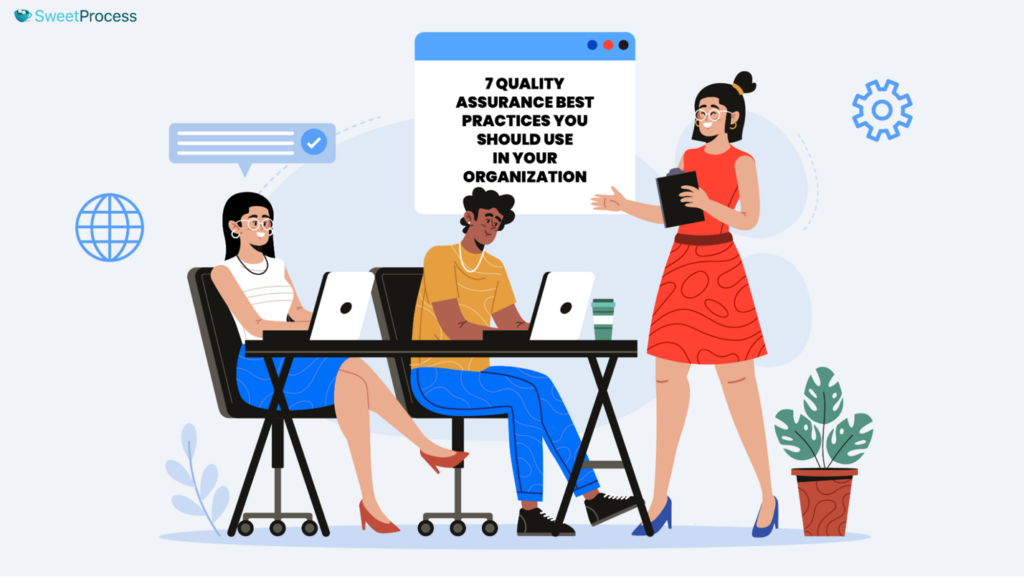
Here are some practices you can use to help you instill quality assurance in your business:
1. Establish Quality Objectives & Standards
To meet customers’ expectations, abide by regulations, and remain profitable, you must have these objectives at the core of any quality assurance initiatives in your business. However, you have to ensure they are specific, measurable, and time-bound. Let’s say you do code; you can list out the objectives for your developers and software testers to be sure that everyone is on the same page.
2. Quality Planning
This involves setting standards for quality in every step of production to meet regulatory requirements and industry standards. If you run a manufacturing business, you can identify possible risks, such as low-quality raw materials that can lead to subpar products, to enable you to detect inferior supplies like that and maintain product quality.
3. Quality Assurance Process Design
Designing an efficient quality assurance process is key in making sure products meet quality standards. In, say, a health facility, the manager can fix up quality gates for patient intake, conduct proper diagnosis to find hidden reasons behind symptoms, and also set careful treatment protocols to treat diseases.
4. Quality Assurance Testing
It’s not enough to design standards for quality—one has to check if they truly meet those requirements carefully. This has to do with verifying and observing if, say, your medical equipment is durable and in good condition. And it has to be thorough and intensive. Perhaps a clinic can conduct usability testing to ensure that the software is easy to use.
5. Quality Assurance Monitoring & Control
Nothing works in quality assurance without a close observation and checkmate. As you lay down the goals and objectives for ensuring quality product or service delivery, ensure you take time to go through every process step or operation to find and fix defects. Also, this inspection has to be continuous and consistent.
6. Gather Customer Feedback & Validation
Getting customer feedback to validate ideas is important in making sure customers’ needs are being met. You can do this using feedback forms or adding comment boxes to your documents on SweetProcess, so you can analyze and make improvements to the design of the product or service quality.
7. Quality Assurance Audits
Conducting quality assurance audits is key to maintaining quality standards on operations. Like in financial institutions, the manager can conduct quality assurance audits to ensure that their processes protect their customers’ interests and meet regulatory requirements or industry standards. This involves capital adequacy, liquidity, and checking for cyber security to prevent hackers from breaching their database or stealing customer money.
6 Approaches to Quality Assurance

There are many ways to implement quality assurance in your business. Let’s go over some of them:
1. Total Quality Management (TQM)
Total Quality Management (TQM) is a holistic way to quality assurance that continuously brings together all staff and stakeholders, like managers or suppliers, in the quality improvement process. It promotes a culture of quality all through the organization through staff training and improved customer service.
- Encourages employee involvement and empowerment
- It’s a continuous process that boosts the business reputation
- More return customers
- Time-consuming
- Capital intensive and costly
- It may not be suitable for small businesses and startups
2. Failure Testing
Failure testing is a method of quality assurance that involves carefully assessing products’ or services’ potential defects and faults. This way, businesses can fix faulty products before they become major issues. It also helps to reduce product recalls and refund requests.
- Helps companies identify potential errors
- Prevents the risks of product failures
- Increases overall quality and durability
- Needs a lot of resources and domain experience to carry out
- It can be costly to carry out
- It might not pinpoint every single fault in service or products and could be time-consuming
3. Process and Product Quality Assurance (PPQA)
Process and product quality assurance (PPQA) is another method to improve quality assurance that has to do with keeping processes and products up to standard. It involves reviewing operations and testing packaged products on the shelf.
- Ensures both the process and finished goods are high-quality
- Helps to find and fix defects beforehand
- Improves customer satisfaction
- It may not be suitable for small-scale businesses
- Time-consuming and complicated
- Needs a lot of resources to carry out
4. Statistical Control
This approach helps businesses find and resolve product defects to improve their quality and reliability using statistical tools and techniques like regression analysis and control charts to analyze process performance and find areas that need adjustment.
- Prevents the risk of product defects or service failure
- Helps identify and resolve defects
- Improves product quality and durability
- Quite difficult to implement
- Requires technical know-how statistics
- Can take so much productive time to implement
5. Models and Standards
In the models and standards approach, quality assurance involves using established frameworks and guidelines to maintain product and service quality. Some of them include ISO 9001 and Six Sigma.
- Gives a straightforward framework for quality assurance
- Helps ensure consistent standards in products or services
- Enhances product and service quality
- Hard to implement in small firms
- Need lots of resources and expertise to make it work
- Too bureaucratic and rigid
6. Company Quality
Company quality is a method that ensures everything in a company maintains high standards. In this approach, every single part of the company, including processes and products, is assessed to ensure they meet customer expectations and are of good quality.
Pros
- Improved customer satisfaction
- Better business reputation
- Fewer customers complaints
Cons
- Takes time to see the results
- Slow production rate due to strict inspections
- It might cost a little more to produce and ship out products
No matter what method of approach you want to adopt, SweetProcess can help make the process easier. But don’t take our word for it. Sign up for a 14 day free trial today to see how our platform can help you. No credit card required.
Quality Assurance Examples in Different Industries [+ How It Works]

Quality assurance does not work the same way in every sector. Let’s take a look at how they operate across industries:
Quality Assurance in Healthcare
Quality assurance helps to ensure that patients are well treated with care and shown maximum support.
For example, a hospital or clinic can set a quality assurance system to check and improve healing rate by checking metrics like doctors’ punctuality, nurses’ empathy, patients’ satisfaction score, infection rates, and medication dose error rates. This information can then be used to improve where they are lagging, like if clients wait too long on queues, they can speed up the process to cut down the wait time.
Quality Assurance in Banking
Banks use quality assurance to reduce transaction errors and ensure that customers feel safe and secure enough to run transactions with them and be in compliance with regulatory bodies. They typically improve this by checking the percentage of transaction failures, security breaches, banking app glitches, or customer complaints versus good review rates to know what exactly they need to work on to increase customer trust.
Quality Assurance in Customer Service
Customer loyalty in this sector depends on how fast their inquiries are attended to and how satisfied they feel when their expectations are met. In a situation where their satisfaction is low, they can apply quality assurance to ensure that the questions and complaints are addressed in less time than they used to take so that customers can have a better experience and stay loyal to the brand.
Quality Assurance in Software Testing
In software testing, quality assurance helps to launch software apps that are glitch-free, strong and reliable. They can make this happen by launching a demo app to a few users to test run and give feedback about their experience. Then, they use their review to work on the backend and remove glitches or malware to reduce maintenance costs.
Quality Assurance in Government
In government, quality assurance ensures that public servants are fast in delivering services to members of the public. Quality metrics can be used to ensure people get better services, such as feedback or suggestion boxes, to gather reviews and ideas from those who use the service. This way, areas needing improvement, like service quality or delivery times, can be improved to reduce complaints.
Quality Assurance in Manufacturing
Quality assurance can be used in manufacturing to make better products and reduce production costs. A company can pick products randomly to check defects when customers complain a lot, as it’s a clear sign they need to make adjustments. To cut down the high rate of product recalls or defects in finished goods, they can apply quality assurance by hiring staff or using a machine that can carefully sort out faulty products and supervise the production process, and cut down errors.
Quality Assurance in the Pharmaceutical Industry
In the pharmaceutical industry, quality assurance helps to keep medicines safe and effective and meets regulatory requirements. For instance, it can be used to monitor and improve manufacturing processes such as batch yield drug purity rates to maintain quality and also comply with medical regulatory boards. This helps to reduce waste and increase returning buyers and patronage from hospitals and clinics who see the efficacy of their drugs in treating patients.
Want to see how SweetProcess can help your industry in real-time? You can sign up for a 14-day free trial today to see how our platform can help you easily plan, manage, and improve your quality assurance in your business.
Quality Assurance vs. Quality Control: How Do They Differ?
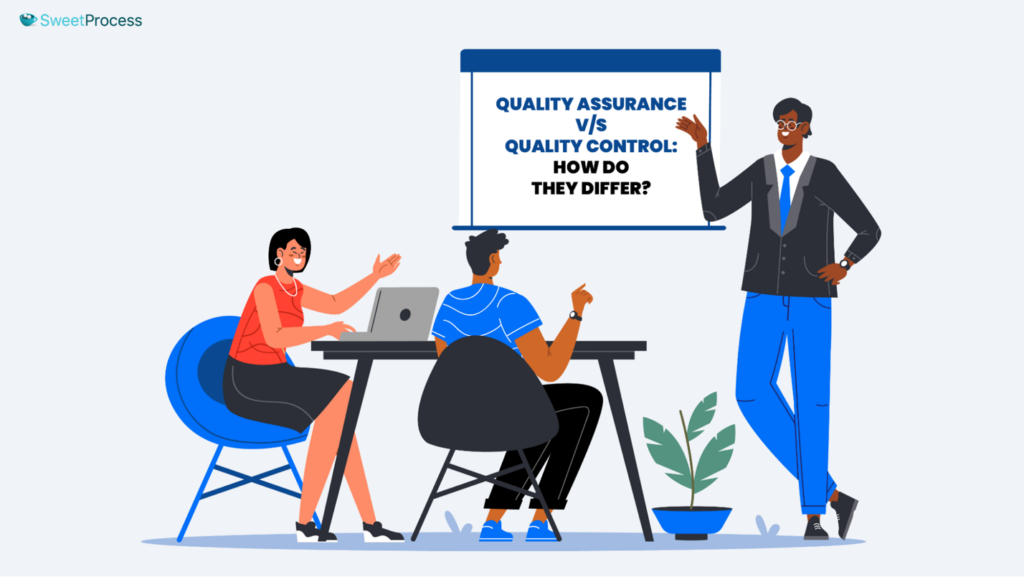
To give you a clear picture of how they differ, let’s use a tabular form to show you the major differences between quality assurance and quality control.
| Feature | Quality Assurance (QA) | Quality Control (QC) |
| Focus | Process-driven | Product based |
| Approach | Proactive approach | Reactive strategy |
| Objective | Avoid process errors | Detect and fix errors |
| Activities | Auditing, staff training, reviews | Inspection and tests |
| Results | Better systems | Quality products |
| Team | Quality assurance team | Quality control team |
Whether you’re going for quality control or assurance, SweetProcess makes it seamless. Plus, there’s no credit card required to try it for up to 14 days.
Enhance Your Company’s Quality Assurance Process Using SweetProcess

Quality assurance is essential to growing a successful business as it helps you maintain quality, retain customers, and stay profitable without unnecessary legal drama.
But it’s hard to get it right without proper documentation of these quality procedures. Yes, writing them down in a manual book or PDFs and Word comments can help. But it’s hard to stick to those principles when there’s no single platform to house it all and keep everyone on the same page.
However, setting it up is super easy when you sign up for a tool like SweetProcess.
Sign up for a 14-day free trial today and see how our intuitive platform can help you document, manage, and improve your quality assurance processes.
